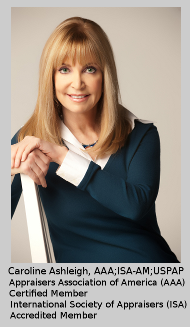|
DETERMINING AUTHENTICITY
One of the Elements of a Correctly Prepared Appraisal
Victor Wiener, former Executive Director, AAA
The determination of whether an object is authentic or not may prove to be the most important factor in establishing value. The real Picasso is worth more than the fake; a real diamond will fetch a significantly higher price than its synthetic imitation. Yet, determining the authenticity of a piece may be the most difficult of all functions an appraiser has to perform.
The concept of authenticity embraces two essential considerations: what is meant by “authentic” and who is the correct person to judge whether a piece is authentic or not. What is considered to be authentic for one type of object may not be considered to be authentic for another. Standards of authenticity vary greatly from field to field. For example, while collectors of European furniture see nothing wrong with major restoration, those who concentrate on American furniture may judge a piece with minor additions to be “fake.”
Given such conflicting data, one might rightly ask, “Who is the one to determine whether a piece is correct or not?” Many appraisers would agree that they are not the ones to make the primary determination.They would argue that it is too much to ask a generalist to pass judgment on an object in a highly specific category. Even when the appraiser specializes in a relatively small area, he or she may not feel totally qualified to authenticate a particular object – and the market may not be prepared to accept the opinion of the appraiser as the primary authenticator. For example, an appraiser of impressionist paintings would not be the one to authenticate a Renoir that is unknown to the market. An authenticator, by definition, is the one who specializes in a highly specific and, frequently, narrow field. For this reason, appraisers frequently rely on third party sources as authenticators.
If appraisers are not authenticators per se, one may ask, who is? Various categories of “experts” come to mind, but each category carries with it a history of academic and legal challenges to the opinions of specific experts.
Auction houses may be considered, by many, to be the most qualified to determine whether a piece is authentic or not since all sales are public, and catalogues receive worldwide distribution and scrutiny. But auction house experts frequently defer to the opinions of others, and even that has not protected them from lengthy and nasty lawsuits.Both Sotheby’s and Christie’s have been entangled in litigation connected with objects ranging from Faberge eggs to Mary Cassatt paintings.
Dealers of deceased artists are frequently called upon to authenticate objects, but they, too, have had their opinions challenged in court. Klaus Perls, the exclusive agent for Alexander Calder was disqualified by the court in a case concerning a contested Calder mobile. And, the internationally prominent print dealer, David Tunick, challenged, in court, the opinion of the internationally prominent Swiss auctioneer Eberhard Kornfield over a Picasso print with a disputed signature
Famous scholars are frequently questioned about their judgment when problems of authenticity arise. The exhibition of all Rembrandt paintings owned by the Metropolitan Museum of Art presented numerous challenges by the Museum’s staff to the opinions published by the Rembrandt Research Project, a group of Dutch scholars, who, for decades, had passed judgment on the authenticity of Rembrandts held in public and private collections.
On the other hand, museum staff members frequently are not in agreement with one another. At the same time as the Rembrandt exhibition, the MET held an exhibition of Goya’s. Gigantic chat labels on the walls revealed to the general public an internal controversy among the staff concerning the authenticity of two versions of Goya’s Majas on a Balcony. One version, belonging to a private French collection, is universally accepted as a genuine Goya, but the MET’sstaff is divided in its judgment of the MET’s version. The curatorial staff believes it to be a copy by a follower of Goya, but the Conservation Department of the Museum believes it to be an authentic work whose authorship has been obscured by its poor conservation.Unable to make a firm public commitment, the Museum displayed both paintings, side by side, and relied upon the public to make up its own mind for itself.
Recently, authentication committees have been established by the estates of deceased artists. But, the judgments of these committees have been hotly contested – especially when the members of the committees are also involved in the marketing and sales of the holdings left to them by the estate of the deceased. Charges of “conflict of interest” have been raised against the authentication committees of Keith Haring, Yves Klein and Alexander Calder, among others. Disgruntled owners of disputed works have claimed that these committees are reluctant to authenticate works owned by others because the art market is not large enough to support too many works by one artist.
In some European countries, such as Italy and France, family members of the deceased artists are legally the ones to have the ultimate word on authenticity, even though they may be generations removed from their ancestors. As strange as this may seem to an American audience, the “moral right” (droit moral) of these descendants is well established in the local courts and American appraisers must take this into consideration.
The opinions of living artists, about their own works, have been questioned as well. Giorgio de Chirico (1888-1978) was accused of painting fakes of his earlier, metaphysical paintings, during the last years of his life, since his earlier works were more valuable than the ones painted circa 1970. |

